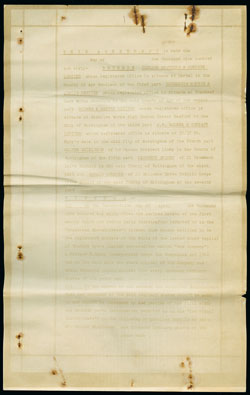Storage hazards
There are lots of methods for gathering documents together, but some can actually harm the precious items that people are trying to keep safe.
Metal fastenings and boxes
Metal pins, paperclips and staples often rust over time, especially in damp conditions. The rusty metal sticks to the document and leaves stains. The pins are hard to remove without tearing the document. The image below shows rusty stains and brittle areas left by paperclips and staples which have since been removed. The document is a photostat or photocopy of a draft deed. It only dates from 1964 but is already extremely faded, as this old reprographic method has not turned out to be a suitable long-term solution.
)

Photostat agreement, 1964 (BWL/2/1/2)
It was common to store pendant seals attached to deeds within metal boxes called 'skippets', like this one shown here. Unfortunately, skippets do not give adequate protection and the seals within them are often found to be broken.
Broken seal inside metal skippet attached to a licence from Peter le Neve, Norroy King of Arms, 1706 (MD 682)
String, tape and other binding methods
Tying string around a bundle of items can tear the sides of the documents. Flat tape is less likely to cause damage, but the pigment in commercial tape often used by lawyers (‘red tape’) often comes off onto the paper, leaving pink stains.
Bundles tied with tight string and 'red tape' (from Acc 1271)
Item previously tied with 'red tape', which has left stains on the right-hand side (Pl E12/6/5/70/1)
Elastic bands degrade after only a few years. They stop becoming effective at holding documents together, and they also leave stains. They become hard and brittle and can be difficult to remove.
Self-adhesive tape such as Sellotape also causes irreversible damage.
Front and back sides of letter reinforced with self-adhesive tape (La C 113). The tape has been applied to the back of the letter (right) but the glue stains have come through to the front (left)
Folders and albums
Commercial plastic folders contain lots of chemicals that can react with the items kept inside them. In the worst cases, papers can become stuck to the folders in which they are stored.
In the same way, chemicals in commercial ‘sticky’ photograph albums react with the prints and cause them to become faded and discoloured. Glues cause similar damage. Lamination is also a chemical process, and the intense heat combined with the glue damages the original material.
Fragment of the story of St Bridget, formerly glued to a book binding; the glue has caused permanent staining W(WLC/LM/38)
Next page: Preservation and conservation